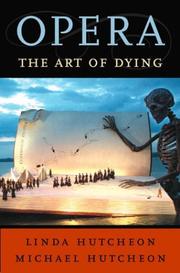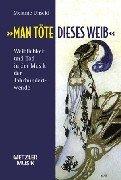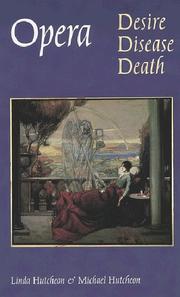| Listing 1 - 7 of 7 |
Sort by
|
Book
ISBN: 1527575357 Year: 2021 Publisher: Newcastle-upon-Tyne, England : Cambridge Scholars Publishing,
Abstract | Keywords | Export | Availability | Bookmark
 Loading...
Loading...Choose an application
- Reference Manager
- EndNote
- RefWorks (Direct export to RefWorks)
An aspect of dying in opera, rarely observed or commented on, is Sudden Unexpected Death. There are many deaths in this melodramatic genre: most follow expected causes like murder, suicide, or old age. This book explores those deaths which occur without obvious natural causes. These are often central to the overall drama of the opera, representing denouements forming the epiphany of the story and the apotheosis for the audience. The book identifies 50 operas where such events occur, exploring the role of the dramatis personae, the circumstances of their dying, and specific themes that emerge. These include a preponderance of females, especially in the 19th century, who die mainly at the end of the operas, often in the context of tragedy. It charts the growing awareness in the medical sciences of the unconscious forces driving human behaviour, including liminal mental states and trances, which influenced these operas and continue to affect human behaviour to the present day. In addition, the changing philosophies that are intertwined with operatic narratives, in particular stemming from Kant, Hegel, Schopenhauer and Nietzsche, are important in the book's exegesis, as is the special role of Wagner's compositions. This leads to the exploration of recurrent concepts such as the Liebestod, the ewig Weibliche and redemption itself.

ISBN: 0674013263 Year: 2004 Volume: *5 Publisher: Cambridge, Massachusetts London, England Harvard University Press
Abstract | Keywords | Export | Availability | Bookmark
 Loading...
Loading...Choose an application
- Reference Manager
- EndNote
- RefWorks (Direct export to RefWorks)
Death in opera --- Dood in de opera --- Mort dans l'opéra --- Death in opera.

ISBN: 0674038916 9780674038912 9780674013261 0674013263 9780674335639 0674335635 0674013263 Year: 2013 Publisher: Cambridge, MA
Abstract | Keywords | Export | Availability | Bookmark
 Loading...
Loading...Choose an application
- Reference Manager
- EndNote
- RefWorks (Direct export to RefWorks)
Our modern narratives of science and technology can only go so far in teaching us about the death that we must all finally face. Can an act of the imagination, in the form of opera, take us the rest of the way? Might opera, an art form steeped in death, teach us how to die, as this provocative work suggests? In Opera: The Art of Dying a physician and a literary theorist bring together scientific and humanistic perspectives on the lessons on living and dying that this extravagant and seemingly artificial art imparts. Contrasting the experience of mortality in opera to that in tragedy, the Hutcheons find a more apt analogy in the medieval custom of contemplatio mortis--a dramatized exercise in imagining one's own death that prepared one for the inevitable end and helped one enjoy the life that remained. From the perspective of a contemporary audience, they explore concepts of mortality embodied in both the common and the more obscure operatic repertoire: the terror of death (in Poulenc's Dialogues of the Carmelites); the longing for death (in Wagner's Tristan and Isolde); preparation for the good death (in Wagner's Ring of the Nibelung); and suicide (in Puccini's Madama Butterfly). In works by Janacek, Ullmann, Berg, and Britten, among others, the Hutcheons examine how death is made to feel logical and even right morally, psychologically, and artistically--how, in the art of opera, we rehearse death in order to give life meaning.
Death in opera. --- Opera --- MUSIC / Genres & Styles / Opera. --- MUSIC / General. --- Opera.
Book
ISBN: 0803223676 Year: 1996 Volume: 17 Publisher: Lincoln : University of Nebraska Press,
Abstract | Keywords | Export | Availability | Bookmark
 Loading...
Loading...Choose an application
- Reference Manager
- EndNote
- RefWorks (Direct export to RefWorks)
Sex in opera --- Diseases in opera --- Death in opera --- Sexualité dans l'opéra --- Maladies à l'opéra --- Mort à l'opéra

ISBN: 3476018091 9783476018090 Year: 2001 Publisher: Stuttgart : Metzler,
Abstract | Keywords | Export | Availability | Bookmark
 Loading...
Loading...Choose an application
- Reference Manager
- EndNote
- RefWorks (Direct export to RefWorks)
Death in music. --- Death in music. --- Death in opera. --- Death in opera. --- Feminine beauty (Aesthetics). --- Feminine beauty (Aesthetics). --- Femininity and music. --- Frau --- Frauenbild. --- Musik. --- Seduction --- Seduction --- Sex in music. --- Sex in music. --- Sex in opera. --- Sex in opera. --- Tod --- Weiblichkeit --- Women in music. --- Women in music. --- Women in opera. --- Women in opera. --- Psychological aspects. --- Psychological aspects. --- Geschichte 1880-1920. --- Geschichte 1890-1910.

ISBN: 0803273185 9780803273184 Year: 1996 Publisher: Lincoln (Nebr.) : University of Nebraska press,
Abstract | Keywords | Export | Availability | Bookmark
 Loading...
Loading...Choose an application
- Reference Manager
- EndNote
- RefWorks (Direct export to RefWorks)
"This fascinating book looks at well-known operas in which love, sexual desire, illness, and death are inextricably linked. The result is an unprecedented view of the operas themselves and the societies in which they were created." "The book focuses on operatic representations of disease and on the ways in which operas associate illness with sexuality, gender, and desire. The authors consider the frequent operatic alliance of tuberculosis with female sexuality (as in Verdi's La Traviata and Puccini's La Boheme); the relation between venereal disease and the moral transgression or failure of male heroes (as in Wagner's Parsifal and Stravinsky's The Rake's Progress); and the association of cholera and homosexual desire in Berg's Lulu and Britten's Death in Venice. A virtuosic chapter considers how assorted operas have identified smoking with sexuality and rebellion. The conclusion considers parallels between earlier operatic representations of disease and recent cultural and scientific representations of AIDS."--Jacket.
Death in opera. --- Diseases in opera. --- Krankheit --- Maladies à l'opéra. --- Medicine in the Arts. --- Music. --- Oper. --- Opera --- Opera's. --- Opéra --- Seksualiteit. --- Sex in opera. --- Sexualité à l'opéra. --- Sociale aspecten. --- Tod --- Ziekte. --- Social aspects. --- Aspect social.
Book
ISBN: 9782869311282 2869311281 Year: 2011 Publisher: Paris Minerve
Abstract | Keywords | Export | Availability | Bookmark
 Loading...
Loading...Choose an application
- Reference Manager
- EndNote
- RefWorks (Direct export to RefWorks)
Opera --- Death in opera --- Disasters in art --- Opéra --- Mort à l'opéra --- Catastrophes dans l'art --- Music --- Symbolism in opera --- Tragedy in music --- Gluck-Piccinni controversy --- Querelle des Bouffons --- Comic opera --- Lyric drama --- Opera, Comic --- Operas --- Drama --- Dramatic music --- Singspiel --- History and criticism --- Frankrijk --- 18e eeuw
| Listing 1 - 7 of 7 |
Sort by
|

 Search
Search Feedback
Feedback About UniCat
About UniCat  Help
Help News
News